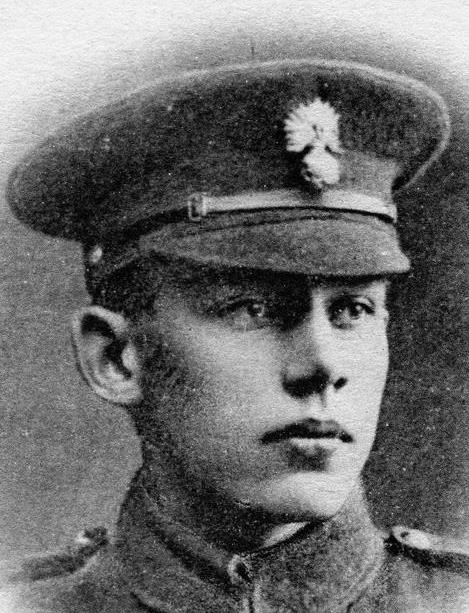Pte
Joseph Mark Tatton
Informations sur naissance
|
Année de naissance: 1898 |
|
Lieu de naissance: Birmingham, Warwickshire, Angleterre, Royaume-Uni |
Informations générales
|
Profession: Élève |
Informations service militaire
|
Pays: Angleterre, Royaume-Uni |
|
Force armée: British Expeditionary Force |
|
Rang: Private |
|
Numéro de service: 10309 |
|
Incorporation date: 13/06/1916 |
|
Incorporation nom de lieu: Armoury House, Old Ford, Middlesex, Angleterre, Royaume-Uni |
|
Unités: — Honourable Artillery Company, 2/1st Bn. (Dernière unité connue) |
Informations sur décès
|
Date de décès: 09/10/1917 |
|
Lieu de décès: Butte, Polygon Wood, Belgique |
|
Cause du décès: Killed in action (K.I.A.) |
|
Âge: 19 |
Cimetière
|
Buttes New British Cemetery, Polygon Wood Parcelle: II Rangée: A Tombe: 4 |
Distinctions et médailles 2
|
British War Medal Médaille |
|
Victory Medal Médaille |
Points d'intérêt 2
| #1 | Lieu de naissance | ||
| #2 | Lieu d'enrôlement |
Mon histoire
Private Joseph Mark Tatton served in the Honourable Artillery Company 2nd/1st Battalion, part of the 22nd Brigade, of the 7th Division. The 7th Division participated in the Battle of Poelcapelle, a stage in the Third Battle of Ypres. It advanced with the 22nd Brigade from east of Polygon Wood towards the village of Beselare. The Brigade’s attack was carried by the 2nd Hounourable Artillery Company and the 2nd Royal Warwickshires; the 9th Devons were in reserve. The task of the 2nd Hounourable Artillery Company was to capture the hamlet of Reutel and gain touch with the 5th Division, on the right flank, about Juniper Cottage. The 2nd Warwicks on their left flanks had to capture Judge Copse and Judge Cottage.
The 2nd Hounourable Artillery Company had already suffered heavy casualties due to German shellfire, while assembling for the attack. Over 40 men were either killed or wounded before the attack commenced. When the assault commenced at 5.20. a.m. the German artillery opened up a barrage on the advancing troops, causing considerable damage and heavy machine-gun fire from Judgse Copse enfiladed the troops. Before 6 a.m. only isolated parties reached their objectives. It was not until midday that the Battalion had reached their final objective in the hamlet of Reutel. It cleared part of the cemetery east of the hamlet, but was held up short of Juniper Cottage by machine-gun fire. During the night three platoons of the 9th Devons cleared Judge Copse, thusly securing all the 7th Divison’s objectives. The Germans kept on shelling the captured positions during the rest of the night, but they didn’t counter attack and the positions were further consolidated on the next day.
Private Joseph Mark Tatton, 19, was killed on the 12th of October 1917. He was initially buried in at the Butte, in Polygon Wood. This may indicate that he fell, due to the heavy German shelling prior to the attack. Private William Sidney Francis Poole’s remains were exhumed after the war and interred at Buttes New British Cemetery, Polygon Wood.
The 2nd Hounourable Artillery Company had already suffered heavy casualties due to German shellfire, while assembling for the attack. Over 40 men were either killed or wounded before the attack commenced. When the assault commenced at 5.20. a.m. the German artillery opened up a barrage on the advancing troops, causing considerable damage and heavy machine-gun fire from Judgse Copse enfiladed the troops. Before 6 a.m. only isolated parties reached their objectives. It was not until midday that the Battalion had reached their final objective in the hamlet of Reutel. It cleared part of the cemetery east of the hamlet, but was held up short of Juniper Cottage by machine-gun fire. During the night three platoons of the 9th Devons cleared Judge Copse, thusly securing all the 7th Divison’s objectives. The Germans kept on shelling the captured positions during the rest of the night, but they didn’t counter attack and the positions were further consolidated on the next day.
Private Joseph Mark Tatton, 19, was killed on the 12th of October 1917. He was initially buried in at the Butte, in Polygon Wood. This may indicate that he fell, due to the heavy German shelling prior to the attack. Private William Sidney Francis Poole’s remains were exhumed after the war and interred at Buttes New British Cemetery, Polygon Wood.
Sources 3
|
2 Battalion Honourable Artillery Company , (The National Archives, KEW (TNA), WO 95/1662/1). https://discovery.nationalarchives.gov.uk/details/r/C14303 Autre référence |
|
McCarthy C., The Third Ypres Passchendaele. The Day-by-Day Account, (London, Arms & Armour Press, 1995), pg. 57. Sources utilisées |
|
Walker G., The honourable artillery company in the Great War : 1914-1919, (London, Seeley Service & Co., 1930), pg. 322-325. Sources utilisées |
Complément d’informations 3
|
Commonwealth War Graves Commission Database https://www.cwgc.org/find-records/find-war-dead/casualty-details/480468 |
|
Namenlijst (In Flanders Fields Museum) https://namenlijst.org/publicsearch/#/person/_id=6ecf17ed-1443-433d-a5c3-45f62eaec6de |
|
Lives of the First World War (Imperial War Museum) https://livesofthefirstworldwar.iwm.org.uk/lifestory/4387183 |
